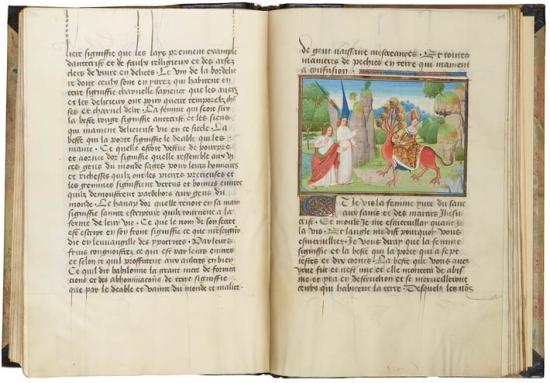
Epistolary and Apocalypse of Charles the Bold, in French
Illuminated by Loyset Liédet and his workshop
Purchased by Pierpont Morgan, 1905
Dressed extravagantly in scarlet cloth of gold, the Whore of Babylon rides the seven-headed beast. Although this manuscript was created around 1470, the Whore's headgear dates to the 1450s. Atop toweringly tall reticulated temples rests the thick rolls of a V-shaped burlet, behind which fall the dags of what was originally the burlet's cape. This headgear can go no further: it is as tall — and its burlet as close together — as can be. By 1470 it was seen as not just old-fashioned, but also decadent. (The styling of the Whore's gown, however, is characteristic of the period around 1470.)
Peacocks of the Midcentury
In 1435, during the final chapter of the Hundred Years' War, Duke Philip the Good switched sides and supported King Charles VII. By the following year, the English occupation of Paris ended. When Charles VII regained Normandy and Aquitaine in 1453, the long war was finally over. In the ensuing period of peace and prosperity, fashion revived.
These decades saw the last of the houpeland. It continued to be worn by men and women in provincial areas, but in France and Flanders it was appropriate only for formal occasions. Men more often wore the gown: full or knee length, belted at the waist. Over the course of these thirty years, men's gowns, via flaring pleats and ample shoulder padding, assumed a flattering, V-shaped silhouette. While the chaperon remained popular, new hats also arrived.
Women's gowns featured wide V necks with contrasting collars and partlets (plackards worn at the midriff). Headgear atop the temples continued to evolve, growing ever more extravagant. Burlets got thicker and climbed higher. Butterfly veils, supported by wires, floated like sails above ladies' heads.
